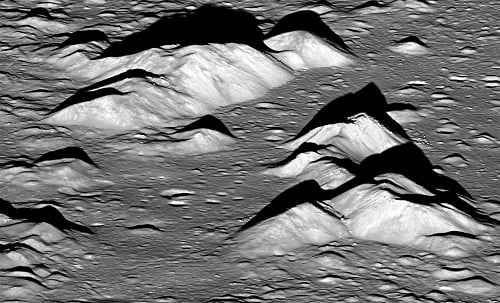Planetary scientists at Brown University have introduced an infrared spectroscopic method for studying olivine, a mineral that provides insights into the formation of the moon, Mars, and other planetary bodies. Informally dubbed “crossover spectroscopy,” the scientists deployed the technique to examine the spectral range in between the visible near-infrared (0.5 to 3 μm) and the mid-infrared ranges (8 to 15 μm). The researchers honed in on the 4 to 8 μm range, and, even more specifically, in the spectral features of olivine at 5.6 and 6.0 μm.

A mountain peak at the center of the moon's Copernicus crater has an abundance of olivine, a mineral that can help scientists understand the internal evolution of planetary bodies. Courtesy of NASA/GSFC/Arizona State University.
“In an optical sense, the ‘cross-over’ region is defined for silicate minerals as the transition between body scattering and surface scattering of photons,” Christopher Kremer told Photonics Media. Kremer is a Ph.D. candidate at Brown University and lead author on the paper describing the work.
Current remote sensing methods are capable of spotting olivine from orbit, though they cannot deliver finer details about the nuances of the mineral’s chemical composition. All olivine deposits have silicon and oxygen, though some are rich in iron. Some others contain magnesium.
In the past few decades, Kremer said, there has been interest in near-infrared and mid-infrared spectroscopy. Between those ranges, though, is a small range that has been left out, he said.
In applying the crossover spectroscopy technique to look at that range, the researchers were able to successfully predict the iron and/or magnesium content of an olivine sample within about 10% of the actual content. The accuracy of prediction marked a significant improvement over that achieved with previous methods.

The researchers tested their method by evaluating samples of olivine that had been examined by the Keck/NASA Reflectance Experiment Laboratory (RELAB), which is housed at Brown. The chemical compositions of those samples were viably comparable; through other techniques, the chemical compositions of those samples had been previously determined at high precision.
“With the instruments we have now, we could say, ‘maybe we have a little bit of this or a little bit of that,’ but with this, we’re able to really put a number on it, which is a big step forward,” said Jack Mustard, a professor of earth, environmental, and planetary sciences at Brown University.
The research, Kremer said, is a fairly simple and reliable method for determining the chemical composition of olivine, and it is able to provide insight into the evolution of planets. The relative amounts of iron and magnesium in olivine’s crystal structure, he said, can provide information about the magma that the olivine formed from, including its temperature.
“This is a particularly important problem on the moon, which is used as a model system for thinking about how other planetary bodies may have evolved,” Kremer said.
The researchers hope that their work will provide the impetus to build and fly a spectrometer to capture those previously overlooked wavelengths and provide more information on the nature of olivine deposits on the moon, and in the future, other planets in our solar system and beyond.
“The olivine samples brought back during the Apollo program that we’ve been able to study here on Earth vary widely in magnesium composition,” Kremer said. “But we don’t know how those differing compositions are distributed on the moon itself, because we can’t see those compositions spectroscopically. If we could figure out a pattern to how those deposits are distributed, it could tell us something about the early evolution of the moon.”
The research was published in Geophysical Review Letters (www.doi.org/10.1029/2020GL089151).